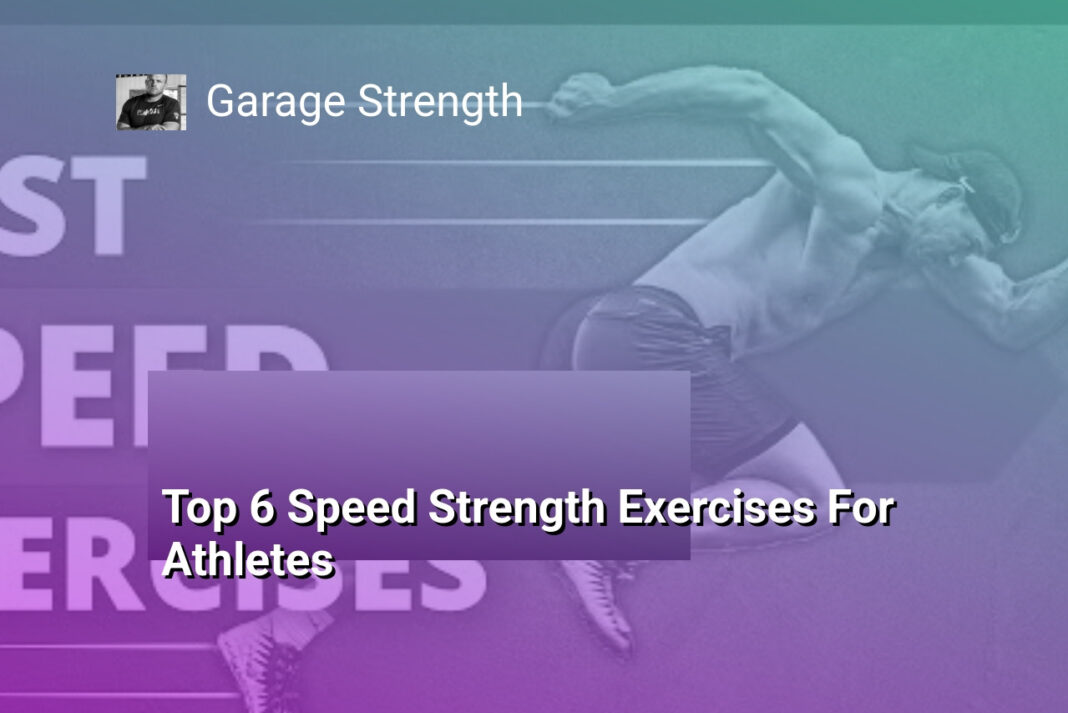The Bottom Line:
Here’s the summary in the requested format:
- I discovered that chain-based resistance training offers smoother sprint acceleration compared to traditional methods, helping athletes control movement and minimize jerking motions.
- The 10 Yard Fly technique involves strategic speed buildup over 20-30 yards, enabling athletes to achieve and maintain peak velocity through precise timing and stopwatch tracking.
- Ankle and foot strength can be dramatically improved through targeted exercises like Ankle Push Iso, which emphasizes forefoot engagement and precise knee positioning.
- Advanced strength training techniques like Hang Power Cleans and Romanian Deadlifts provide comprehensive muscle development, focusing on technical proficiency and targeted strength building.
- Single leg squats emerge as a powerful training method for acceleration, strategically engaging glutes and hamstrings while promoting muscular balance and explosive power.
Resisted Acceleration Training with Chains
Biomechanical Advantages of Chain Resistance
Chain resistance training provides a unique approach to sprint acceleration by creating variable resistance throughout the movement. Unlike traditional weight training, chains offer a dynamic loading mechanism that increases resistance as the athlete extends through the sprint motion. This progressive resistance challenges muscular recruitment patterns, forcing athletes to generate more force against increasing weight. The chains’ design allows for smooth resistance application, minimizing sudden jerking motions that could potentially disrupt sprint mechanics.
Technical Implementation and Execution
Proper attachment of chains is critical for effective resisted acceleration training. Athletes typically connect chains to a weighted belt or harness, ensuring even weight distribution across the body’s posterior chain. The recommended chain weight should represent approximately 10-15% of the athlete’s body weight to maintain optimal biomechanical efficiency. During sprint acceleration, athletes must focus on maintaining proper posture and drive phase mechanics while managing the additional resistance. The goal is to create a smooth, powerful acceleration that challenges neuromuscular coordination and strength development.
Performance Enhancement Mechanisms
Resisted acceleration training with chains triggers several physiological adaptations that contribute to sprint performance. The variable resistance stimulates increased muscle fiber recruitment, particularly in fast-twitch muscle groups responsible for explosive movements. By forcing athletes to generate more force against progressively increasing resistance, the training method enhances rate of force development and overall power output. Additionally, the chains’ unique loading pattern improves proprioceptive awareness and teaches athletes to maintain optimal body positioning under increasing mechanical stress. Coaches and athletes should integrate chain resistance training strategically, typically incorporating 2-3 sessions per week during specific training phases to maximize neuromuscular adaptations without inducing excessive fatigue.
10 Yard Fly Speed Development Method
Mechanics of High-Velocity Sprint Progression
The 10 yard fly method represents a sophisticated sprint development technique designed to enhance an athlete’s maximum velocity potential. Unlike traditional acceleration drills, this approach focuses on transitioning from initial acceleration to top-end speed with precise biomechanical execution. Athletes initiate the drill by building momentum over a 20-30 yard gradual acceleration phase before entering a targeted 10-yard maximum velocity segment.
Technical Execution and Performance Parameters
Precise timing and controlled acceleration are critical components of this training method. Athletes must maintain a horizontal body position with minimal vertical oscillation, ensuring efficient force transmission through ground contact. Utilizing a stopwatch becomes essential for tracking incremental speed improvements and maintaining consistent technical parameters. The goal is to progressively reduce ground contact time while maximizing stride length and frequency.
Neurological Adaptation and Speed Development
Implementing the 10 yard fly technique triggers significant neurological adaptations within an athlete’s central nervous system. By repeatedly practicing this controlled acceleration protocol, neuromuscular pathways are refined, enabling more rapid recruitment of fast-twitch muscle fibers. The drill specifically targets the transition between initial acceleration and maximum velocity, a critical phase often overlooked in traditional sprint training methodologies. Athletes can expect improvements in stride mechanics, power output, and overall sprint efficiency through consistent and structured implementation of this advanced training approach.
Ankle and Foot Strength for Sprinters
Biomechanical Foundations of Foot Stability
Sprinters require exceptional ankle and foot strength to generate explosive power and maintain optimal biomechanical efficiency during high-speed movements. The intricate network of muscles, tendons, and ligaments in the foot and ankle complex plays a critical role in force transmission, shock absorption, and directional control. Developing targeted strength in these areas can significantly enhance sprint performance by improving ground contact time, reducing injury risk, and maximizing energy transfer through the kinetic chain.
Specialized Ankle Conditioning Techniques
Implementing specific exercises that target foot and ankle musculature is essential for sprint-specific performance. Isometric ankle push exercises, performed with a slight knee bend and emphasis on pushing through the big toe and forefoot, can dramatically improve proprioception and muscular engagement. These exercises not only strengthen the smaller stabilizing muscles but also enhance neuromuscular control critical for maintaining proper sprint mechanics. Athletes should focus on precise movements that challenge the ankle’s range of motion and load-bearing capacity, integrating techniques that simulate the explosive demands of sprinting.
Progressive Strength Development Strategies
Advanced sprinters must adopt a comprehensive approach to foot and ankle conditioning that goes beyond traditional strength training. This involves incorporating multi-dimensional movements that challenge the foot’s intrinsic muscles while maintaining dynamic stability. Unilateral exercises such as single-leg squats provide an excellent mechanism for developing asymmetrical strength and addressing potential muscular imbalances. By progressively increasing the complexity and intensity of foot-focused conditioning protocols, athletes can develop a robust foundation that supports high-velocity sprint performance. The key is to create a training methodology that seamlessly integrates foot and ankle strength development with overall sprint-specific athletic preparation.
Advanced Lower Body Power Exercises
Explosive Unilateral Lower Body Movements
Single leg training represents a critical component of advanced sprint development. By focusing on unilateral exercises, athletes can address muscular imbalances and enhance overall lower body power generation. Single leg squats specifically target the glutes, hamstrings, and stabilizing muscle groups essential for sprint acceleration. When performing these movements, athletes should maintain strict form, emphasizing controlled descent and explosive concentric phases. The goal is to develop strength symmetrically while improving proprioceptive awareness and joint stability.
Dynamic Strength and Power Integration
Advanced sprint training demands a sophisticated approach to lower body power development. Combining hang power cleans with Romanian deadlifts creates a comprehensive strength protocol that enhances rate of force development. The hang power clean develops explosive triple extension mechanics, while Romanian deadlifts build posterior chain strength and resilience. Athletes should focus on technical precision, gradually increasing load and complexity as movement quality improves. Key performance indicators include smooth bar path, controlled eccentric phases, and consistent power output across repetitions.
Specialized Hamstring Conditioning
Targeted hamstring training plays a crucial role in sprint performance and injury prevention. Nordic hamstring curls represent an advanced eccentric strength exercise that challenges the posterior chain’s capacity to generate and absorb force. While technically demanding, these movements can significantly improve hamstring resilience and sprint mechanics. Athletes should introduce these exercises progressively, starting with assisted variations and gradually increasing volume and intensity. Complementary exercises like seated hamstring curls and glute-ham raises can provide additional neuromuscular stimulus and support comprehensive lower body development.
Nordic Hamstring and Single Leg Strength Protocols
Hamstring Resilience and Injury Prevention
Nordic hamstring curls represent a critical intervention for athletes seeking to develop posterior chain strength and reduce injury risk. These eccentric-focused exercises specifically target hamstring muscle groups, creating remarkable adaptations in muscle architecture and neuromuscular control. Athletes should progressively integrate these movements, starting with assisted variations and gradually increasing difficulty. Typical progression involves controlling descent speed, maintaining rigid trunk positioning, and utilizing partner assistance during initial learning phases.
Unilateral Strength Development Strategies
Single leg strength protocols demand precise execution and strategic programming. By implementing unilateral movements like single leg squats, athletes can address muscular imbalances, enhance proprioception, and develop sport-specific strength capacities. The key lies in maintaining proper alignment, engaging core stabilizers, and executing movements with controlled tempo. Recommended parameters include performing 5 sets of 3 repetitions, focusing on quality of movement over absolute load.
Integrated Performance Enhancement
Combining Nordic hamstring curls with single leg strength work creates a comprehensive approach to athletic development. These protocols not only mitigate injury risks but also improve force production, movement efficiency, and overall athletic resilience. Athletes should integrate these techniques systematically, allowing adequate recovery between intense sessions. Monitoring fatigue, maintaining proper technique, and progressively overloading movements are crucial for maximizing training adaptations and minimizing potential negative physiological responses.





